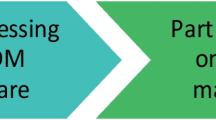Abstract
Additive manufacturing (AM) enables the production of lattice structures with unique properties using different production techniques. In this way, it is possible to obtain the desired mechanical properties by using different production parameters and lattice geometries. In this study, the load behaviors of the octet-truss lattice structure produced by fused deposition modeling (FDM) method with different transition geometries were investigated. Compression tests were carried out on lattice structures and also finite element method (FEM) was performed to determine the stress distributions and deformations. According to the results, it was observed that the transition geometry is an important parameter on the deformation patterns and stress distributions. In the lattice structure without transition geometry, plastic deformation occurred at low-stress values while the transition geometries exhibited plastic deformation at high-stress values. In addition, the effects of the transition geometries on the deformation types were observed. The deformation area on the samples having straight and inclined-transition geometries affected less area than the sample without transition geometry. It was found out that the stretch-dominated deformation type, which significantly affects the strength of the lattice structures subjected to load, was formed in all lattice structures.










Similar content being viewed by others
References
M. Zhang, Z. Yang, Z. Lu, B. Liao, and X. He, Effective Elastic Properties and Initial Yield Surfaces of Two 3D Lattice Structures, Int. J. Mech. Sci., 2018, 138–139, p 146–158.
C. Li, H. Lei, Y. Liu, X. Zhang, J. Xiong, H. Zhou, and D. Fang, Crushing Behavior of Multi-layer Metal Lattice Panel Fabricated by Selective Laser Melting, Int. J. Mech. Sci., 2018, 145, p 389–399.
L. Xiao and W. Song, Additively-Manufactured Functionally Graded Ti-6Al-4V Lattice Structures with High Strength under Static and Dynamic Loading: Experiments, Int. J. Impact Eng., 2018, 111, p 255–272.
A.P.M. Madrid, S.M. Vrech, M.A. Sanchez, and A.P. Rodriguez, Advances in Additive Manufacturing for Bone Tissue Engineering Scaffolds, Mater. Sci. Eng. C, 2019, 100, p 631–644. https://doi.org/10.1016/j.msec.2019.03.037
S. Naghieh, M.R. Ravari, M. Badrossamay, E. Foroozmehr, and M. Kadkhodaei, Numerical Investigation of the Mechanical Properties of the Additive Manufactured Bone Scaffolds Fabricated by FDM: The Effect of Layer Penetration and Post-heating, J. Mech. Behav. Biomed. Mater., 2016, 59, p 241–250.
H. Guo, A. Takezawa, M. Honda, C. Kawamura, and M. Kitamura, Finite Element Simulation of the Compressive Response of Additively Manufactured Lattice Structures with Large Diameters, Comp. Mater. Sci., 2020, 175, p 109610.
K. Ushijima, W. Cantwell, R. Mines, S. Tsopanos, and M. Smith, An Investigation into the Compressive Properties of Stainless Steel Micro-lattice Structures, J. Sandw. Struct. Mater., 2010, 13(3), p 303–329.
P. Li, Z. Wang, N. Petrinic, and C.R. Siviour, Deformation Behaviour of Stainless Steel Microlattice Structures by Selective Laser Melting, Mater. Sci. Eng. A, 2014, 614, p 116–121.
J. Tkac, S. Samborski, K. Monkova, and H. Debski, Analysis of Mechanical Properties of a Lattice Structure Produced with the Additive Technology, Comp. Struct., 2020, 242, p 112138. https://doi.org/10.1016/j.compstruct.2020.112138
A. Entezari, J. Fang, A. Sue, Z. Zhang, M.V. Swain, and Q. Li, Yielding Behaviors of Polymeric Scaffolds with Implications to Tissue Engineering, Mater. Lett., 2016, 184, p 108–111.
P. Li, Constitutive and Failure Behaviour in Selective Laser Melted Stainless Steel for Microlattice Structures, Mater. Sci. Eng. A, 2015, 622, p 114–120.
I. Ullah, M. Brandt, and S. Feih, Failure and Energy Absorption Characteristics of Advanced 3D Truss Core Structures, Mater. Des., 2016, 92, p 937–948.
M. Smith, Z. Guan, and W.J. Cantwell, Finite Element Modelling of the Compressive Response of Lattice Structures Manufactured Using the Selective Laser Melting Technique, Int. J. Mech. Sci., 2013, 67, p 28–41.
N. Jin, F. Wang, Y. Wang, B. Zhang, H. Cheng, and H. Zhang, Failure and Energy Absorption Characteristics of Four Lattice Structures under Dynamic Loading, Mater. Des., 2019, 169, p 107655. https://doi.org/10.1016/j.matdes.2019.107655
S. Farah, D.G. Anderson, and R. Langer, Physical and Mechanical Properties of PLA, and Their Functions in Widespread Applications—A Comprehensive Review, Adv. Drug Deliv. Rev., 2016, 107, p 367–392.
M. Leary, M. Mazur, J. Elambasseril, M. Mcmillan, T. Chirent, and Y. Sun, Selective Laser Melting (SLM) of AlSi12Mg Lattice Structures, Mater. Des., 2016, 98, p 344–357.
M.A. Wagner, T.S. Lumpe, T. Chen, and K. Shea, Programmable, Active Lattice Structures: Unifying Stretch-Dominated and Bending-Dominated Topologies, Extreme Mech. Lett., 2019, 29, p 100461. https://doi.org/10.1016/j.eml.2019.100461
X.Y. Zhang, G. Fang, and J. Zhou, Additively Manufactured Scaffolds for Bone Tissue Engineering and the Prediction of Their Mechanical Behavior: A Review, Materials, 2017, 10(1), p 50.
T. Maconachie, M. Leary, B. Lozanovski, X. Zhang, M. Qian, O. Faruque, and M. Brandt, SLM Lattice Structures: Properties, Performance, Applications and Challenges, Mater. Des., 2019, 183, p 108137. https://doi.org/10.1016/j.matdes.2019.108137
M. Kaur, T.G. Yun, S.M. Han, E.L. Thomas, and W.S. Kim, 3D Printed Stretching-Dominated Micro-trusses, Mater. Des., 2017, 134, p 272–280.
Author information
Authors and Affiliations
Corresponding author
Additional information
Publisher's Note
Springer Nature remains neutral with regard to jurisdictional claims in published maps and institutional affiliations.
Rights and permissions
About this article
Cite this article
Emir, E., Bahçe, E. & Uysal, A. Effect of Octet-Truss Lattice Transition Geometries on Mechanical Properties. J. of Materi Eng and Perform 30, 9370–9376 (2021). https://doi.org/10.1007/s11665-021-06096-2
Received:
Revised:
Accepted:
Published:
Issue Date:
DOI: https://doi.org/10.1007/s11665-021-06096-2




